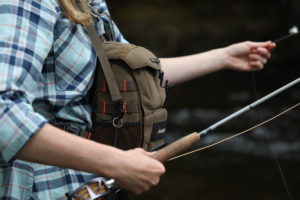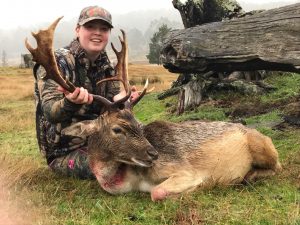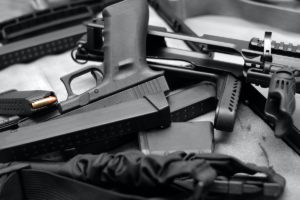 Back in October, we wrote about changes to the fallow deer hunting season in Tasmania that would see the season extended from February to the end of October, as well as the removal of bag limits and tags for antlerless fallow deer (does). We had a number of questions after we published that article from Tasmanian hunters unsure if the new changes had any effect on existing regulations around processing fallow deer in the field. So we took the question directly to the Department of Primary Industries, Parks, Water and the Environment (DPIPWE), the people who look after wildlife management in Tasmania including fallow deer.
Back in October, we wrote about changes to the fallow deer hunting season in Tasmania that would see the season extended from February to the end of October, as well as the removal of bag limits and tags for antlerless fallow deer (does). We had a number of questions after we published that article from Tasmanian hunters unsure if the new changes had any effect on existing regulations around processing fallow deer in the field. So we took the question directly to the Department of Primary Industries, Parks, Water and the Environment (DPIPWE), the people who look after wildlife management in Tasmania including fallow deer.
Current regulations
Hunting fallow deer in Tasmania is governed under the Tasmanian Wildlife (General) Regulations Act 2010. Currently, under section 53(4) of the Act, “a person must not remove the head or sever the body of any deer at a place other than the usual residence of the holder of the licence under which the deer was taken except:
- without the written permission of the Secretary; or
- if all products of the deer have been labelled with the name and address of the licence holder and the numbers of the relevant licence or tag.
Do you still need to bag and tag the head?
As we have all been told, from the start of the Tasmanian fallow deer season in 2020, recreational hunters and holders of Crop Protection Permits will no longer require tags for antlerless fallow deer. However, this has led to some confusion from hunters who aren’t quite sure if the requirements around processing a fallow deer have also changed.
 Here is a sample of one of the (many) questions that we have been asked about the changes:
Here is a sample of one of the (many) questions that we have been asked about the changes:
“As a recreational deer hunter in Tasmania who helps with a large amount of crop protection, I want to know if we will still need to take the entire carcass to our place of residence or will the new changes allow us to break down the animal in the field and only take home the parts of the animal that we can use – like they do in Victoria? As I’m sure you are aware, disposing of a deer head, front legs, rib cage, hooves and skin can be a challenge when you live in a suburban area.”
The response from our contact at DPIPWE is copied below (emphasis retained):
As per section 53(4) of the Tasmanian Wildlife (General) Regulations Act 2010, (which is also stipulated as a compliance obligation on fallow deer Crop Protection Permits), hunters may sever the head or body of a deer at a place other than their residence (e.g. in field, hut, camp etc) provided they label the products with their name, address and numbers of the relevant licence and tag.
In practical terms, for each fallow deer that a hunter takes and decides to sever the body of, Wildlife Rangers upon inspection will expect to see two back legs, two front shoulders, two backstraps and of course the head/antlers all labelled per the above regulation and retained. The head must be retained for sex identification purposes and also verification of the tag numbers that apply to the licence/permit.
Hunters are not expected to retain and label waste items including gut, organs, rib cage, skin, legs below the joint etc.
In the way of antlerless deer for 2020 and the removal of the requirement to tag, hunters will of course label the products with their name, address and licence number only. Retaining of the head for all fallow deer taken will continue to remain a requirement.
To sum this up, it appears the regulations around processing a deer carcass remain the same with one exception: you no longer have to place a tag in the lower jaw of an antlerless deer (doe).
If you want to process fallow deer in the field, you can still do so. However, you will have to clearly label all the parts with your name, address and license or permit numbers AND you will need to retain the head for sex identification purposes.
Do you have any other questions about the changes to the season? Let us know and we’ll try to get some answers for you.
What is I Am Hunter?
I Am Hunter wants to change the way hunting is perceived and to change the conversation from a negative one driven by anti-hunters to a positive one led by hunters.
Our goal is to help hunters become positive role models and ambassadors for hunting, while simultaneously helping non-hunters understand why hunting is important.
You can become a supporter and help us achieve our goal and spread a positive message about hunting with the wider community.
Related content
If you would like to know more about hunting wallabies, kangaroos or deer in Tasmania, check out these related articles and podcasts.
Our other channels
Follow us on Facebook
Follow us on Instagram
YouTube
Subscribe to our YouTube channel.
Get our newsletter
Get our free monthly newsletter direct to your inbox
Listen on iTunes
Listen to our podcast on iTunes.
TV series
Watch I Am Hunter episodes on My Outdoor TV (MOTV)








6 thoughts on “Understanding changes to fallow deer hunting in Tasmania”
You’re welcome.
There are many that share your concerns, Peter. It will be interesting to see how it all unfolds and what impact (both negative and positive) it has on the herds. Unfortunately, there are so many conflicting priorities here. Farmers and Greens want deer gone completely. Hunters like us want them to remain.
My son and I are deer hunters the same as my father before me, we have hunted in most parts of Tassie ,our blood lines, and genetics of our fallow deer are the best in Australia,if we are allowed to shoot does ,from Feburary to October we will soon wipe out our outstanding Fallow Deer population and our grandchrildren will never get to experience the way of life,and experiences of hunting and the thrill of shooting their first stag
I am a deer hunter and have been for over 40 years if we shoot all does from Feburary to October in 3 years there will be no quality stags ,our hunting and storking will dissapear
Thank you .